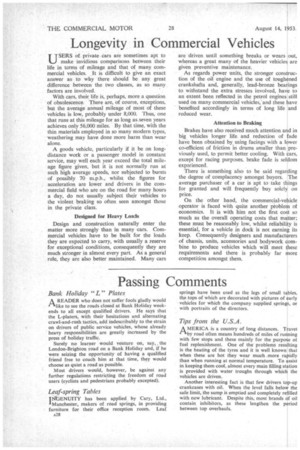Longevity, in Commercial Vehicles
Page 30

If you've noticed an error in this article please click here to report it so we can fix it.
USERS of private cars are sometimes apt to make invidious comparisons between their life in terms of mileage and that of many commercial vehicles. It is difficult to give an exact answer as to' why there should be any great difference between the two classes, as so many factors are involved.
With cars, their life is, perhaps, more a question of obsolescence. There are, of course, exceptions, but the average annual mileage of most of these vehicles is low, probably under 8,000. Thus, one that runs at this mileage for as long as seven years achieves only 56,000 miles. By that time, with the thin materials employed in so many modern types, weathering may have done more harm than wear alone.
A goods vehicle, particularly if it be on longdistance work or a passenger model in constant service, may well each year exceed the total mileage figure given, but it is not normally run at such high average speeds, nor subjected to bursts of possibly 70 m.p.h., whilst the figures for acceleration are lower and drivers in the commercial field who are on the road for many hours a day, do not usually subject their vehicles to the violent braking so often seen amongst those in the private class.
Designed for Heavy Loads Design and construction naturally enter the matter more strongly than in many cars. Commercial vehicles have to be built for the loads they are expected to carry, with usually a reserve for exceptional conditions, consequently they are much stronger in almost every part. As a general rule, they are also better maintained. Many cars are driven until something breaks or wears out, whereas a great many of the heavier vehicles are given preventive maintenance.
As regards power units, the stronger construction of the oil engine and the use of toughened ie crankshafts and, generally, lead-bronze bea ings to withstand the extra stresses involved, have to an extent been reflected in the petrol engines still used on many commercial vehicles;and these have benefited accordingly in terms of long life and reduced wear.
Attention to Braking Brakes have also received much attention and in big vehicles longer life, and reduction of fade have been obtained by using facings with a lower co-efficient of friction in drums smaller than previously used, to permit better cooling. With cars, except for racing purposes, brake fade is sel om experienced.
There is something also to be said regar mg the degree of complacency amongst buyers. The average purchaser of a car is apt to take t ngs for granted and will frequently buy solel on price.
On the other hand, the commercial-ye icle operator is faced with quite another pioble of economics. It is with him not the first co t so much as the overall operating costs that m tter; these must be reasonably low, whilst reliabili y is essential, for a vehicle in dock is not earnin its keep. Consequently designers and manufacturers of chassis, units, accessories and bodyworkcombine to produce vehicles which will meet hese requirements and there is probably far taore competition amongst them.




















































































